Written by Sam and Kels Adventures.
This guide helps you decide if visiting Pamukkale, Turkey, is still worth it, given the concerns about the lack of water and misleading photos online. Famously known as the “Cotton Castle,” Pamukkale is located in the province of Denizli in the south of the country and is one of the most visited tourist destinations in Turkey.
In 2023, it welcomed nearly 1.15 million tourists to its ancient waters and the stunning ancient city of Hierapolis, set against its backdrop.
Despite its popularity, visiting Pamukkale requires some planning. This blog post breaks down all the basics and, more importantly, shares our thoughts on whether it is still worth visiting.
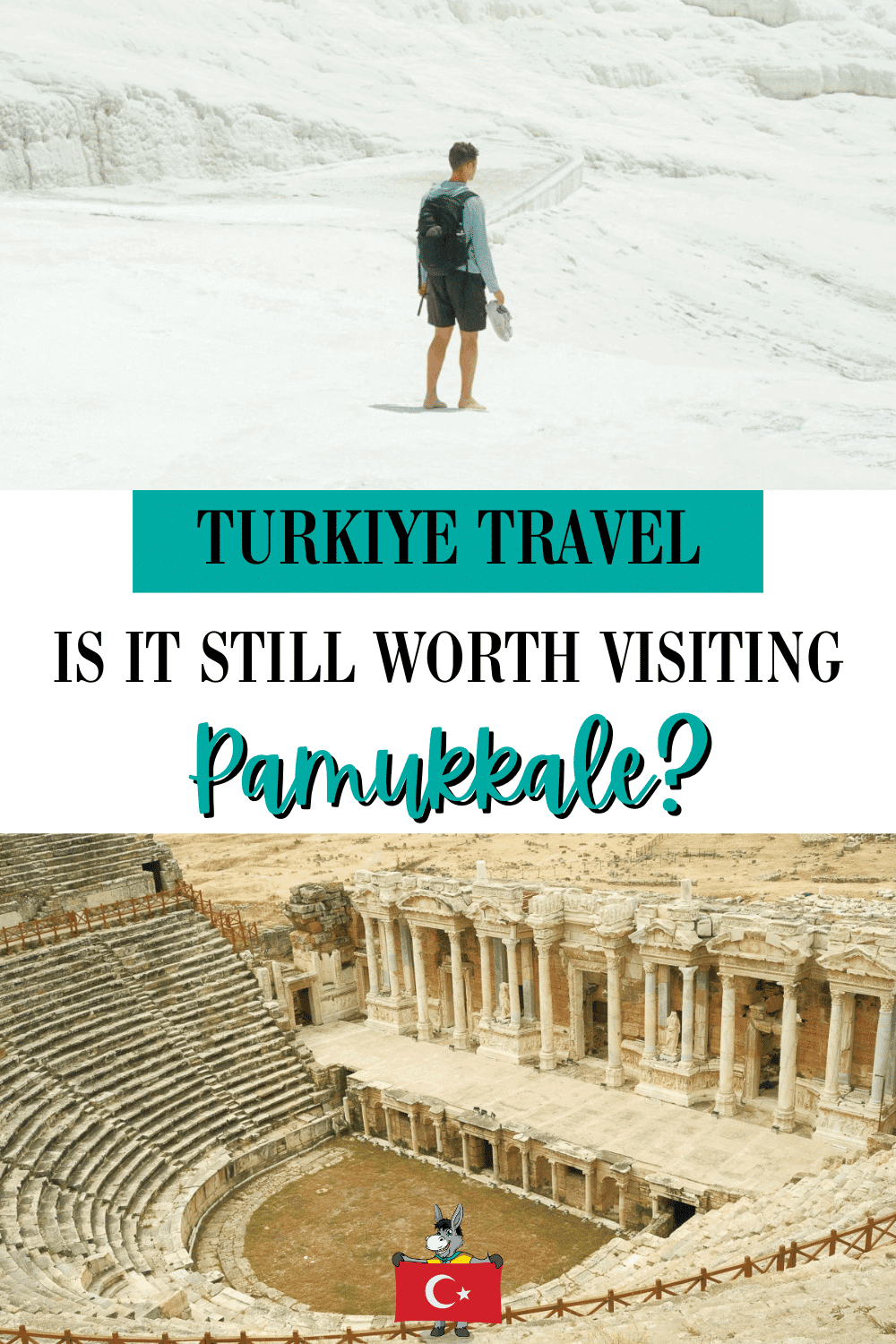
The Pamukkale entrance fee is now 30 Euros (up from 10 last year). If you have the Museum Pass Turkey, it is valid here.
Opening Hours: 08:00 – 20:00, every day
What to bring: Walking shoes, slippers, sunglasses/hat, sunscreen, water,r and snacks!
Plan to spend 3-4 hours walking around Hierapolis and marveling at the travertines. Remember, you cannot reenter the park once you leave, so keep this in mind when planning your day!
Skip Ahead To My Advice Here!
Quick History of Pamukkale
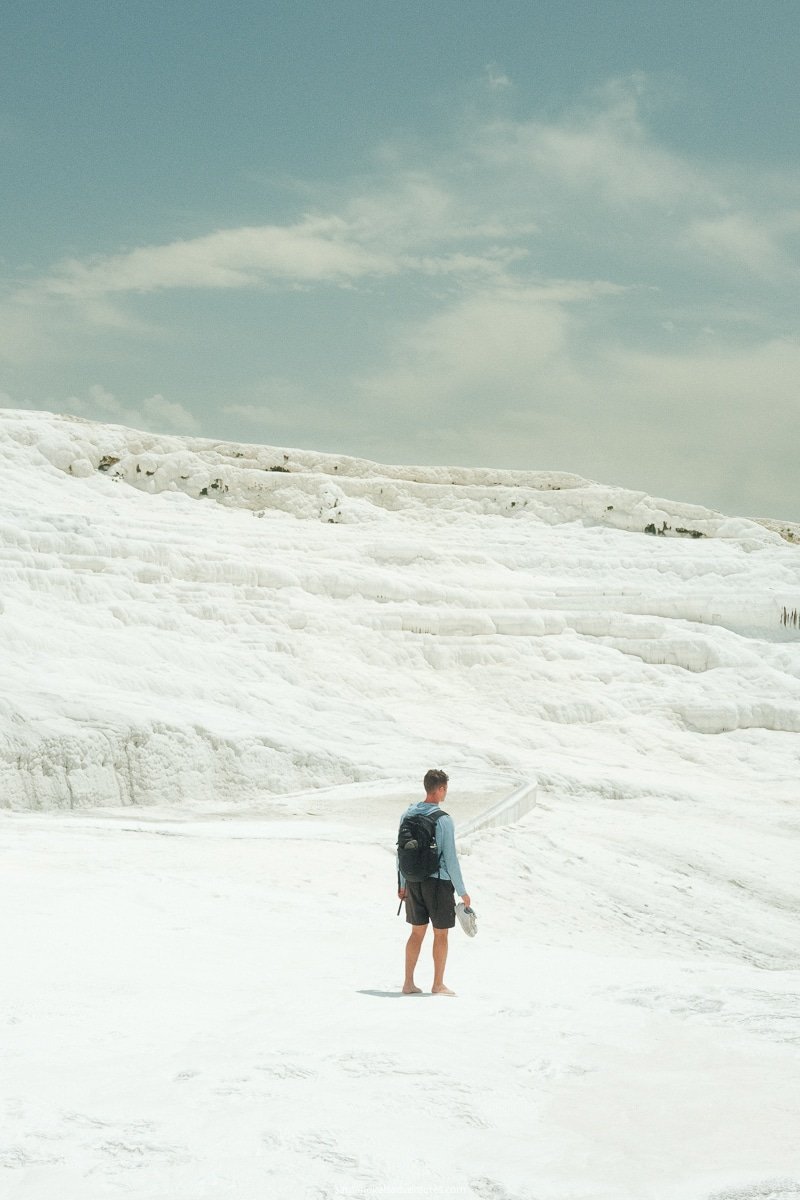
Pamukkale and Hierapolis have a long and important history that dates back to the 2nd century BC. According to the UNESCO World Heritage site, “this extraordinary landscape was a focus of interest for visitors to the nearby Hellenistic spa town of Hierapolis, established by the Attalid kings of Pergamon at the end of the 2nd century BC, at the site of an ancient cult.
In fact, the ancient city of Hierapolis was built around the discovery of the thermal pools and, said to have “healing powers.” With numerous baths located throughout the city, their commitment to cleanliness and bathing was said to be a reason why the city was able to sustain itself for years without many disease outbreaks. The city held significance throughout numerous empires from Greek to Roman, even earning a visit from known figures like the Christian Apostle Paul.
The famous white terraces found in Pamukkale are actually technically called travertine. Travertine is a form of limestone deposited around mineral springs, most especially around hot springs. The rapid precipitation of calcium carbonate causes the sediment to turn into the shapes and terraces we can see today.
Essential Things To Know About Visiting Pamukkale
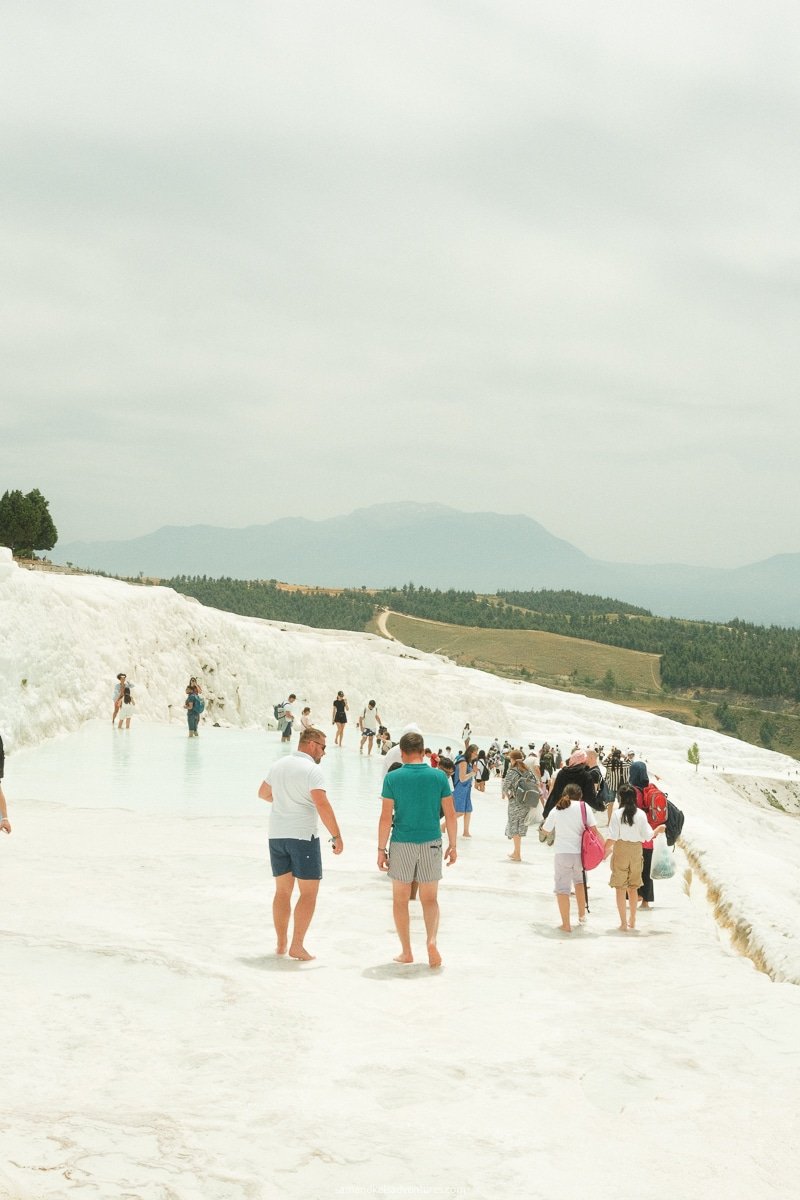
- It will always be crowded no matter when you visit
- You need to figure out which entrance you will take. There are THREE entrances to Pamukkale: The North Entrance, The South Entrance, and the Town Entrance (West)
- Your ticket only allows you to enter the park once. Once you leave, you will not be able to return unless you pay again!
- It costs extra to swim in the Cleopatra Antique Pools (200TL)
- You cannot wear shoes when walking down the travertines! You must be barefoot or wear socks! Take care when walking down the travertines as it is wet, rough, and very slippery
- Most of the pools have dried up over time, so visiting in 2024 does not look like the famous pictures you see from over ten years ago
Pros And Cons Of Visiting Pamukkale
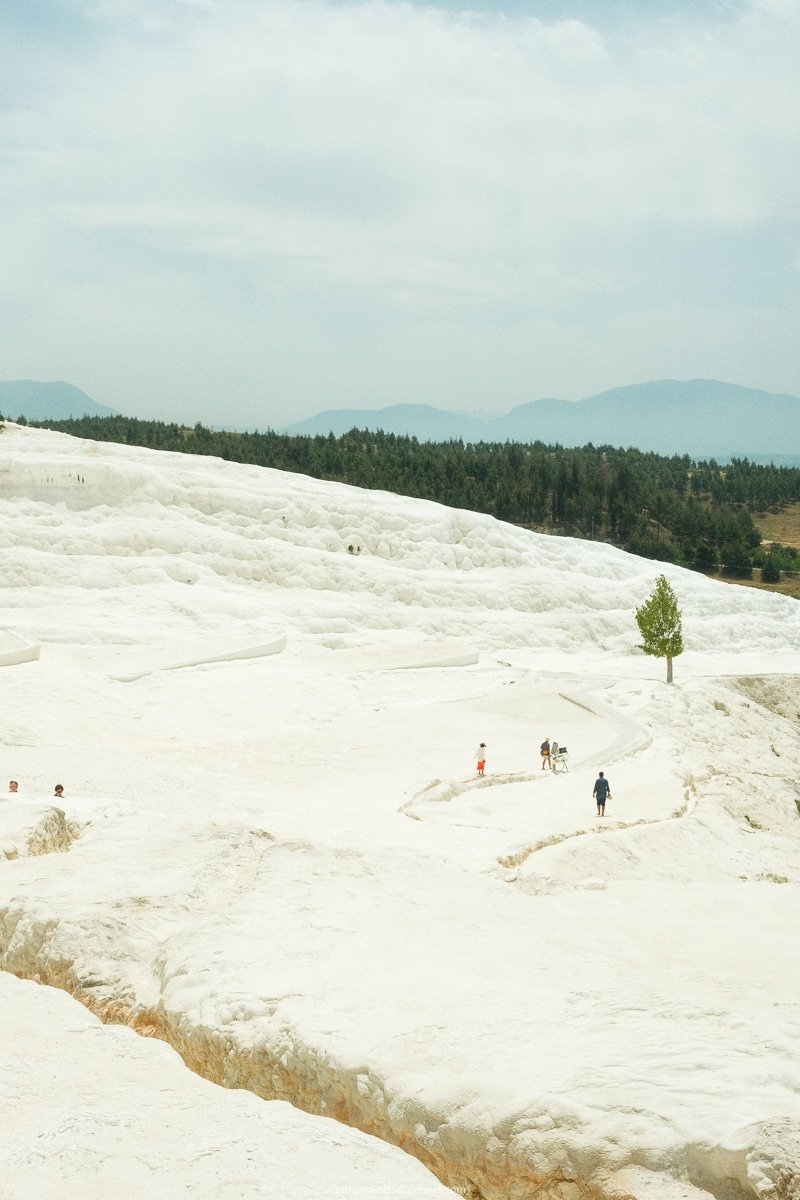
There is a lot to consider when deciding to visit Pamukkale’s Cotton Castle and the ancient city of Hierapolis. To help you decide, in this section, we break down the pros and cons of visiting and things you should consider before making your final decision. and following the pros and cons, you will find my detailed experience with visiting Pamukkale.
Brands We Use And Trust
Pros Of Visiting Pamukkale
- Wow factor. The sights of the travertines and magnificence of the ancient city are strikingly beautiful. Enough said. Pamukkale is a beautiful natural wonder, and being able to immerse yourself in history and the otherworldly sight of the white terraces makes it a pro to visit. There are few places in the world where you can see a sight like this
- Easy to reach. Since Pamukkale is a highly visited tourist destination, it is easy and straightforward to get to no matter what mode of transportation you are looking to use. Although Pamukkale is a bit tucked away from other major tourist cities and destinations in Turkey, it is fairly easy to, especially if you are coming from the Southern Coast. You can see our post on how to rent a car in Turkey as a foreign tourist here
- Family friendly. Visiting Pamukkale is family-friendly. The park is huge, with well-paved paths, benches, picnic tables, and signs that share its history. We would definitely say visiting Pamukkale is family-friendly and a great place to bring kids who are fascinated by history or looking to splash around in the pools of the travertines
Cons Of Visiting Pamukkale
- Changed Travertines: The travertine terraces are not what they looked like ten years ago. They have dried up and lost much of the magic you see in photos online. While they are still spectacular, it’s essential to manage your expectations and know what you are getting into
- It is expensive. 30 euros is a lot of money for an entrance fee. If you are Turkish, your entrance fee is around 2.50 euros, which makes this con inapplicable, but for everyone else, you will have to pay 30 euros. Being a single-entry ticket for a place where people spend an average of 4 hours, it is definitely a con, in our opinion
- Not much else to see around. The town of Pamukkale is small, with little else to do besides paid activities. There are opportunities to paraglide and go on hot air balloon rides, but there is not much else to see in the town of Pamukkale
- Crowded. If you are not a fan of crowds, visiting Pamukkale may not be for you. With millions of tourists flocking to Pamukkale every year (especially during the summer high season), you will always be amongst the crowd. If you are a traveler who likes getting off the beaten path and exploring less visited destinations, Pamukkale might not be the best fit
Our Experience Visiting Pamukkale
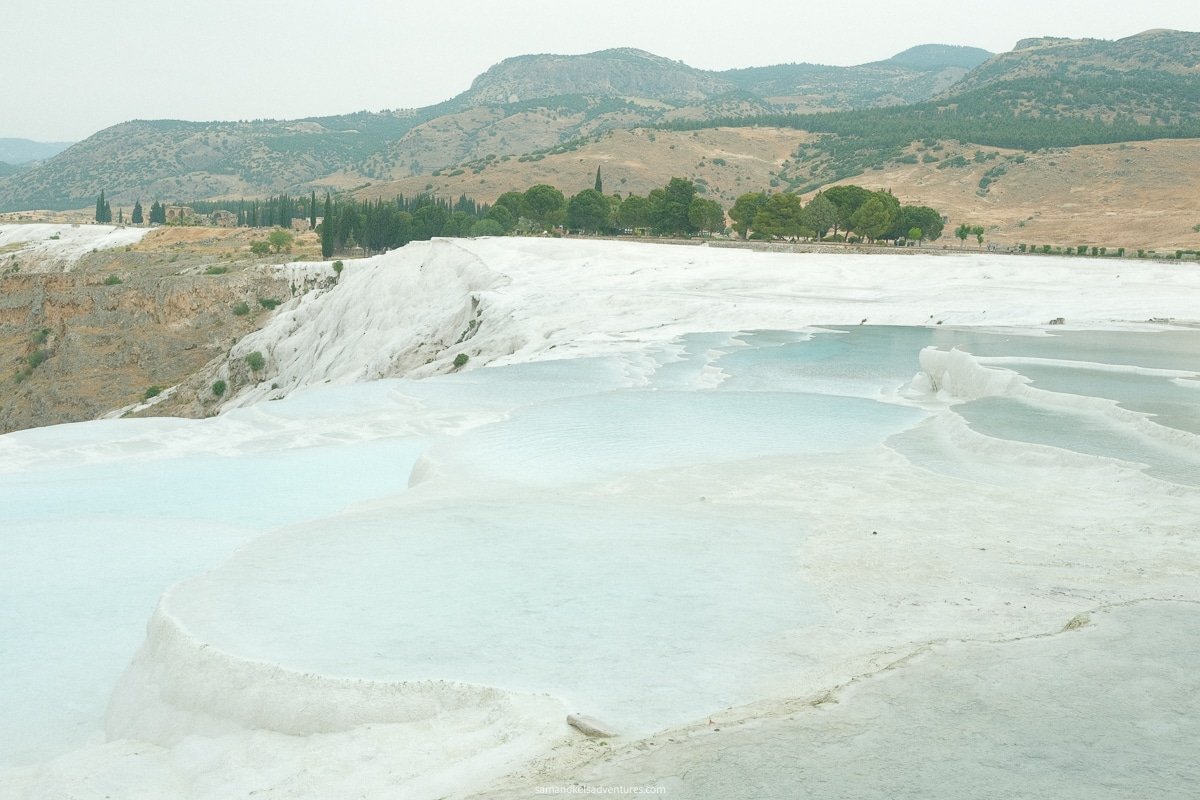
We arrived in the town of Pamukkale on a Monday evening and planned to visit the park the following day bright and early to beat the crowds.
Our hotel was kind enough to offer us a free ride to the South Entrance Gate of Pamukkale, which saved us time as we started at the top of the city rather than climbing up and climbing down through the travertine terraces.
Entering Pamukkale & Hierapolis
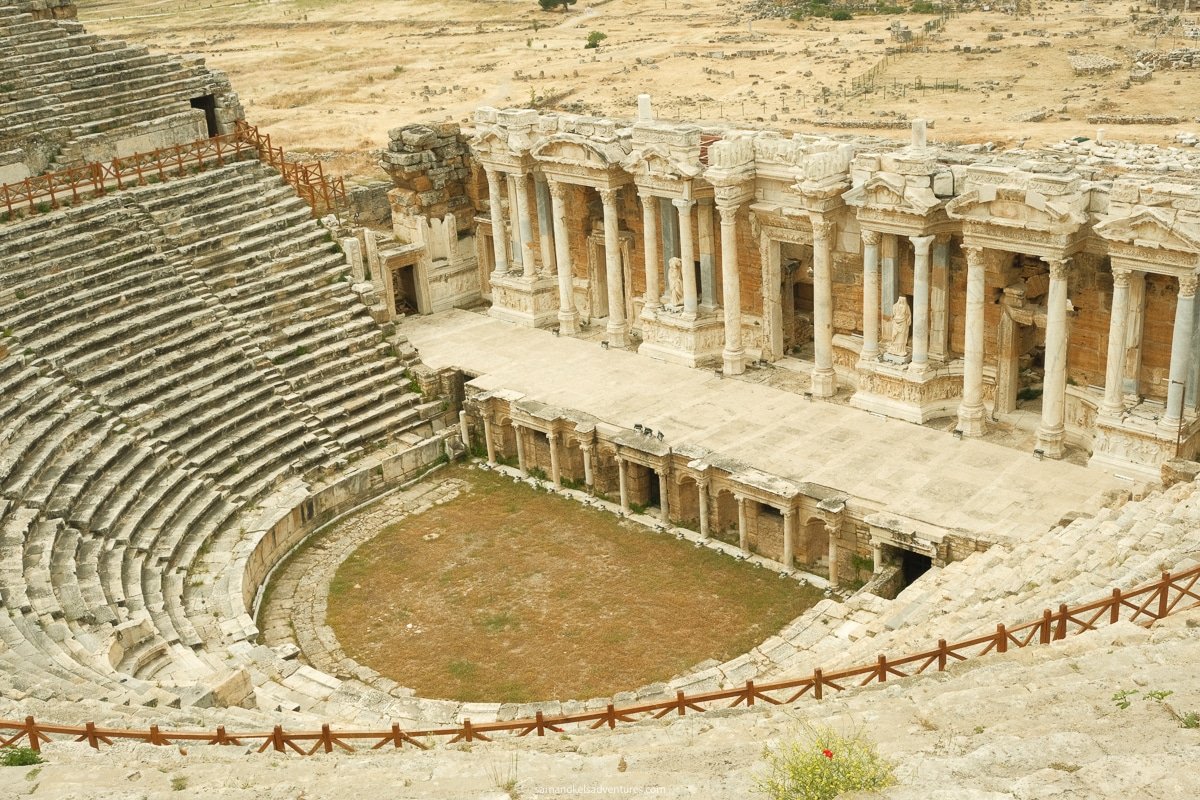
We entered the park around 09:30 AM. The South Gate leads you through the back entrance of Hierapolis. We actually saw that it wasn’t as crowded as we thought it would be. The ancient city of Hierapolis is HUGE and there is plenty of space to wander along by yourself with few people around you.
This makes for a pleasant day walking at your own pace to the different ancient buildings around the city.
We noticed the actual crowded parts of the park are (1) the section of the travertines that visitors are allowed to walk on (also, this is the path that leads to the entrance at the bottom of the town) and (2) the Cleopatra antique pool.
Checking Out Cleopatra Antique Pool
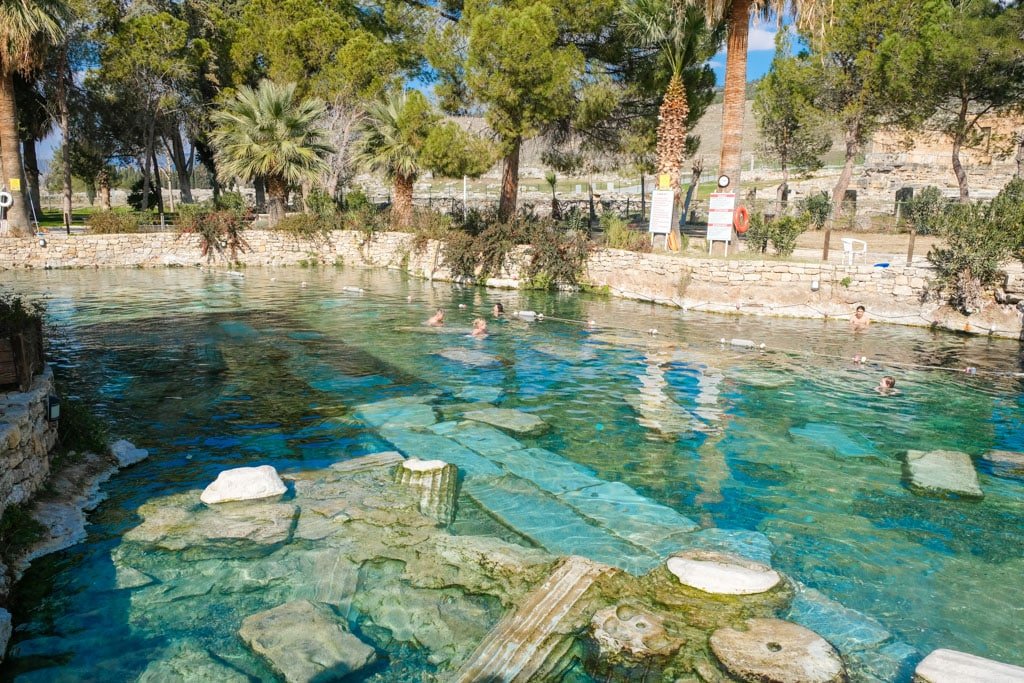
We walked to the Cleopatra Antique Pool to check it out. They’ve built up a lot of restaurants and stores surrounding the pool, so if you are looking for a bite to eat, this is one of the few places inside the park where you can get a proper meal.
Note that entering the pool costs extra (200TL). The facilities around the pool have changing rooms and bathrooms.
After wandering around the park for 3 hours and passing by both of these locations on multiple occasions, the crowds really never let up—it’s just a reality of visiting this park!
Tip: If you walk along the edge of the path near where the people are walking on the travertines, continue past this spot, and walk away from the open section along the path, you will find a second section of the terraces filled with water. This is an excellent spot for pictures, as no one is allowed to walk on the terraces here.
Wandering Around The Ancient City Of Hierapolis
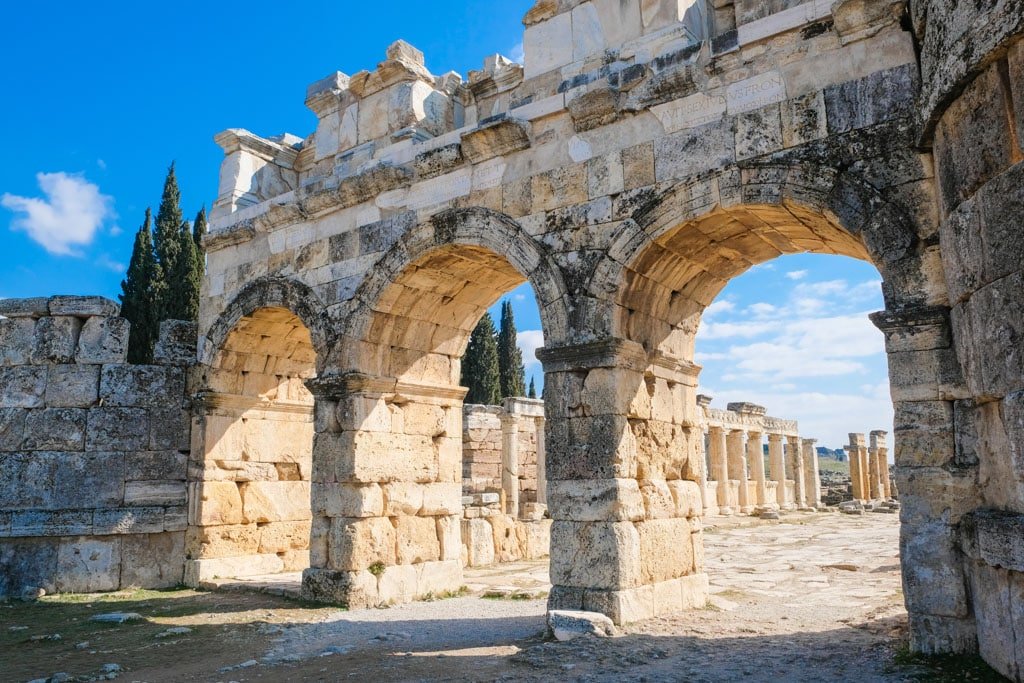
From there, we wandered around the ancient city of Hierapolis, the highlights of which were the amphitheater and the temple of Apollo. You could easily spend an entire day walking around the ancient city if you wanted!
You will notice various large tour groups walking around the grounds throughout your visit. If you time yourself right, you can hit the nice spots when the groups are in transit between different locations. During our visit, we also bumped into many schoolchildren visiting the park for a field trip, which was pretty cute.
You can also choose to enter the Hierapolis Archaeological Museum, which is included in the 30 euro entrance fee. You can visit this to learn more about the city’s history and wonder at various artifacts collected over the years of digging up this site!
Walking Down The White Path – Pamukkale Travertines
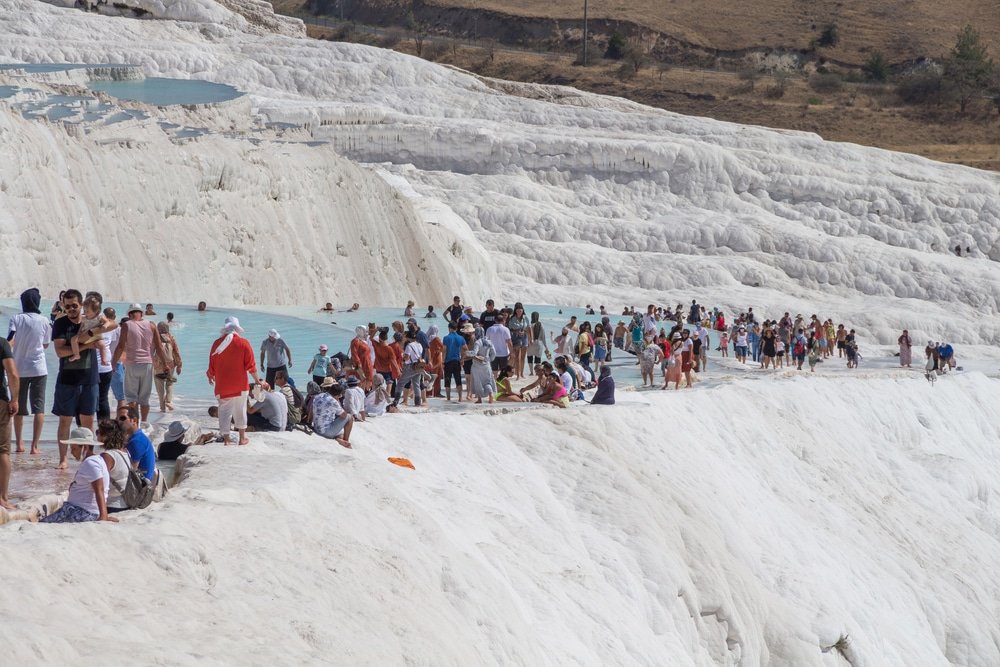
After walking around Hierapolis, we ended our day walking down the famous travertines. Before this point, the clouds blocked the sun, and the weather was pleasant. As we stepped foot on the travertines (barefoot, as required), the sun decided to peek through the clouds in full force.
Fortunately for us, this was a welcome moment for photos as the sun reflected off the white limestone and blue water, making them shine brilliantly. Unfortunately, we did not bring any protective eyewear, like a hat or sunglasses.
Because sunlight reflects on the white, it is incredibly bright and hurts our eyes by the time we make it down the path. We highly recommend you bring a hat or sunglasses on your trip!
Walking down the travertines barefoot was a process. It is slippery since there is water in many sections, and it hurts the soles of your feet because the path is rough.
Don’t be surprised when you have to take it slow because of the pain, but definitely don’t shy away from making the walk, as it is one of the highlights of the entire visit.
In fact, as you walk further down the path, there are fewer and fewer people, so it could be easier to take photos without the crowds.
I would say it took us about 40 minutes total to walk down the path, with many stops for photos and wading in the waters. Be aware that there is water everywhere and only a few dry spots. Expect that your bags and things will get a bit damp if you set them down on the ground to take some pictures!
Once we reached the bottom of the path, we sat down on a bench at the end, slipped our shoes back on, and walked back to Pamukkale town. It was a quick 10 minutes’ walk back to our hotel.
Move This Adventure To Your Inbox & Get An Instant Freebie

No spam. Unsubscribe at any time.
Our Verdict: Is Pamukkale Worth It Anymore?

It really depends! Given that the entrance fee rose significantly from 10 euros in 2023 to 30 euros in 2024, we think that potential visitors need to give a bit more thought before making the trek to Pamukkale. Although relatively straightforward to get to (depending on where you are coming from), the steep entrance fee and the reality of the pools mainly being dry make us come to this conclusion:
We recommend that you visit Pamukkale, but with MAJOR caveats:
- Know what you are getting into when it comes to the travertines! Again, the Travertine Terraces are not what they looked like ten years ago. They dried up and lost a lot of the magic you can see in photos online. But don’t worry too much. They are still spectacular!
- Pamukkale Town is Very Small! The town of Pamukkale is very small, and many of the restaurants are tourist-priced because they can be. There is not too much to do in Pamukkale besides visiting the park and the ancient city
- Be prepared to visit with many people around! You can choose any time of the day to come to the park, but it is pretty much guaranteed that there will always be some crowds
- Be comfortable paying the 30 euro Entrance Fee. We understand this is a lot of money for a single visit, so we want you to be aware of this in order to make the right decision
Don’t get us wrong, we are happy we visited the travertines and the ancient city of Hierapolis. The ancient city was one of the best preserved in Turkey. The white travertine terraces were beautiful despite being dry mostly.
We are grateful for the opportunity to see what the hype is all about, but at 30 euros to enter; we would say that this is definitely overpriced for what you are getting.
You decide whether to include Pamukkale in your next trip to Turkey. I hope this blog sheds some light on the subject and helps you make the best decision for you.
- Best Hotels In Cappadocia, Turkey
- Best Places To Visit In Turkey For Every Type Of Traveler
- Incredible Black Sea Resorts
- What To Pack For Turkey
- Istanbul, Pamukkale & Cappadocia Itinerary
- Guide To Pamukkale Hot Springs
- Travel To Pamukkale Or Cappadocia?
- How To Get From Pamukkale To Cappadocia
- Should You Visit Pamukkale Or Cappadocia?


My route through Turkey can take me through Pumakkale and then stay in Insparta or I can go to Antalya. Which in your opinion is a better place to visit and stay?
I’m headed to Derinkuyu afterwards. Is one route is more scenic than another?
If you prefer a quieter, more authentic experience with natural beauty, Isparta is a great choice, offering serene lakes and the charm of the “City of Roses.” However, if you’re looking for stunning coastal scenery, vibrant nightlife, and historical sites, Antalya is ideal. The route through Antalya is more scenic, with coastal views and dramatic landscapes, making it a more visually appealing journey towards Derinkuyu.